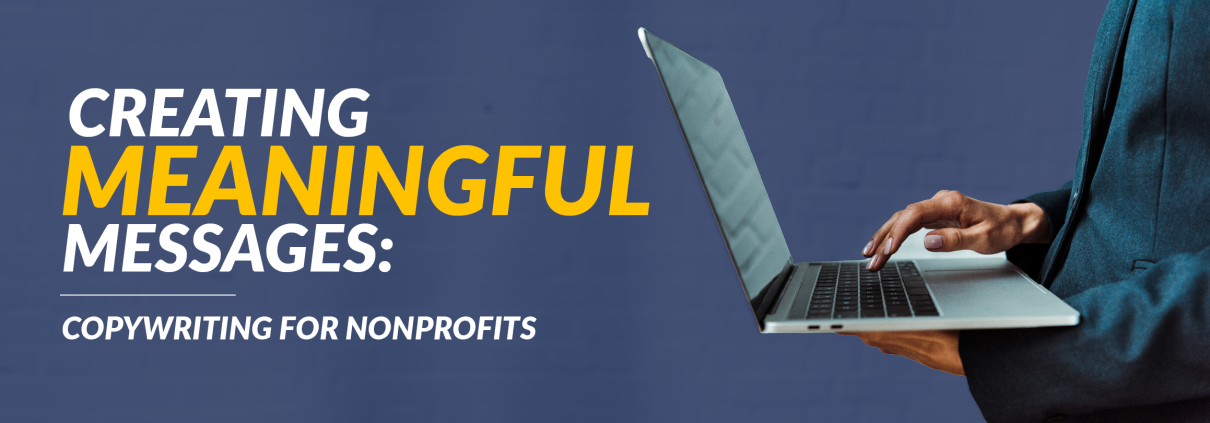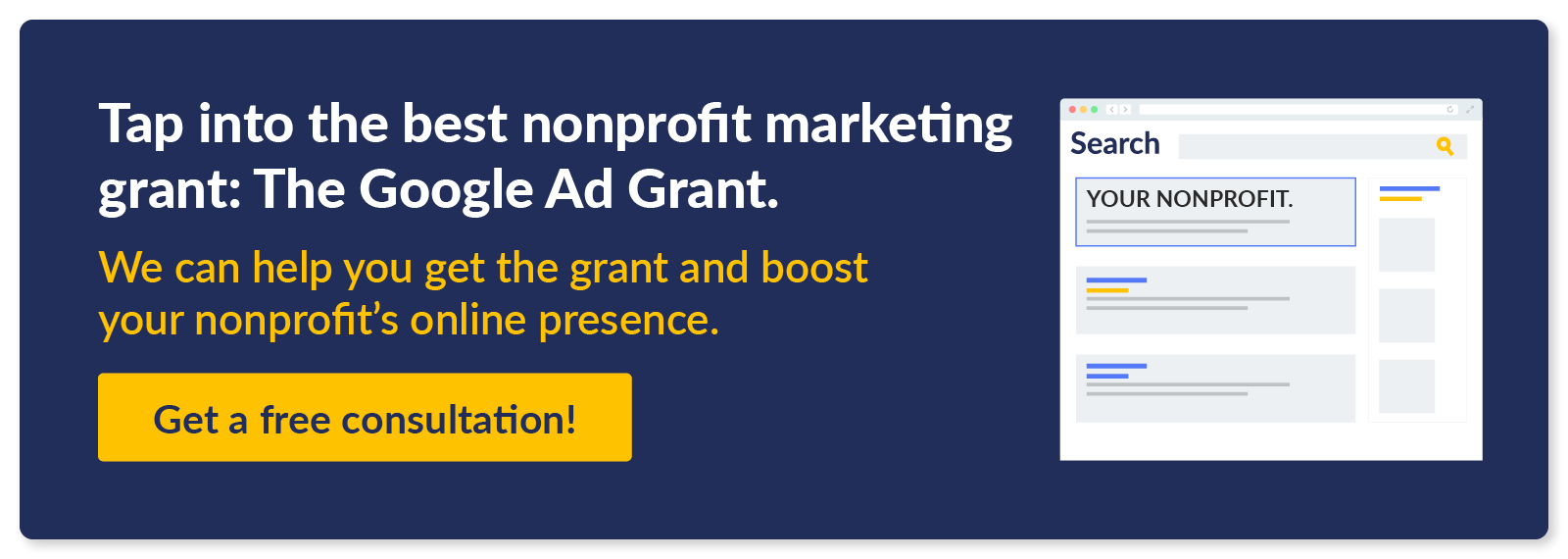Creating Meaningful Messages: Copywriting For Nonprofits
When it comes to marketing your nonprofit, chances are that you’ll be doing a lot of writing. From fundraising appeal emails and thank-you letters to social media announcements and website content, almost all of your nonprofit’s external communications involve text.
As such, this means that every nonprofit, whether they have a dedicated copywriter or not, does copywriting! However, just because every nonprofit is doing it doesn’t necessarily mean every nonprofit has a dedicated strategy.
To improve the quality of your nonprofit’s copywriting, we’ll explore these topics:
- Why Do Nonprofits Need Copywriting?
- Types of Copywriting for Nonprofits
- 9 Copywriting Strategies for Nonprofits
The strength of your copywriting impacts nearly every aspect of how donors interact with your nonprofit. It influences everything from whether they see your organization as professional and reliable to whether they understand your donation page or click on your search ads.
To set your text advertising strategy off on the right foot, let’s first explore a brief overview of copywriting for nonprofits.
Why Do Nonprofits Need Copywriting?
Copywriting is the practice of creating written content for the purpose of persuading an audience to take action. For instance, all of the text that makes up a Google Ad—the headline and description—would be considered copy, and the process of creating that copy is copywriting.

However, copywriting includes more than just advertisements. Again, copywriting consists of all written text created to persuade an audience to take a specific action. This means copywriting for nonprofits includes:
- The text on your donation form
- Donor thank-you messages
- Blog posts
- Social media posts
- Event invitations
- Volunteer recruitment posts
Basically, any time you compose a message meant for an external audience, you are engaging in copywriting.
Types of Copywriting for Nonprofits
While copywriting is a broad category that includes an extensive range of materials, we can still divide nonprofit copywriting into three general categories. These categories are based on the specific types of content you would likely hire a copywriter to produce and encompass most types of nonprofit copy.
Advertising
When it comes to advertising, there are generally two kinds to know: outbound and inbound.
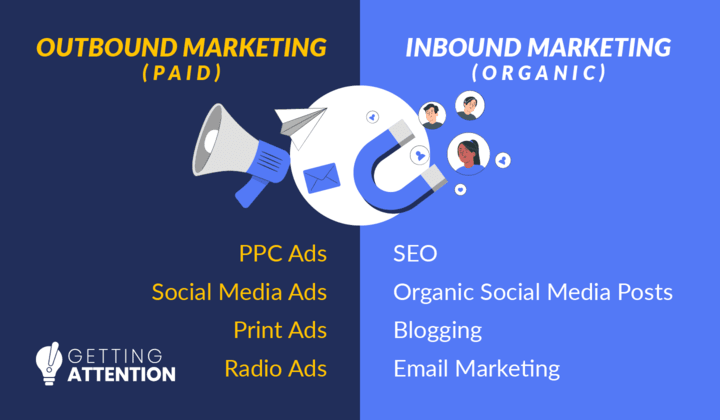
Outbound marketing consists of creating content to be pushed out to a wide audience, regardless of their past interactions, or lack thereof, with your nonprofit. Most types of advertising, such as pay-per-click ads on search engines and social media, are considered outbound marketing. In contrast, inbound marketing usually focuses on content marketing, which we’ll discuss in the next section.
Advertising copy primarily consists of the text on ads. For example, you’ll be conducting advertising copywriting if you create fundraising flyers, run an ad in the newspaper, prepare a script to be read in a radio ad, or use the Google Ad Grant to run search engine ads.
Content Marketing
Content marketing is the process of creating content for the purpose of generating audience interest, which can then lead to conversions.
For example, a nonprofit like the Nonprofit Leadership Alliance (NLA) sells nonprofit professional development courses, like how to improve fundraising, leadership, and organizational skills. To inspire their audience, the NLA produces blog content that provides advice to nonprofit professionals. Individuals impressed by their expertise will then likely continue exploring their website and potentially sign up for a course.
For other nonprofits, written content marketing might consist of:
- Blog posts
- Research reports
- Videos
While videos and research reports may need more than just writing, copywriting is still a core part of producing these materials. After all, someone needs to write your video’s script, and translating complex topics and research into layman’s terms is an essential copywriting skill.
Grant Writing
Grant writing is a highly specialized type of nonprofit copywriting and requires a unique skill set. While some nonprofit professionals may take on grant writing responsibilities, many organizations opt to work with freelance grant writers or take grant writing courses.
Ultimately, most grant writing skills are good for any writer to have, such as the ability to write persuasively, write to a specific audience, and meet tight deadlines. However, because of the pressure to produce successful grant proposals, it’s often worthwhile to work with a professional grant writer rather than attempt to wing it yourself.
Copywriting Strategies for Nonprofits
Whether you plan to write your own copy, provide tips to your marketing team, or hire a third-party copywriting firm, these strategies can help you create and identify strong nonprofit copy.
1. Have a clear goal.
Everything your nonprofit writes should have a purpose. Before writing templates for your fundraising appeals, thank-you messages, or event invitations, consider what your goal is.
For some types of content, your goal will be more obvious than others. For example, it’s common advice not to ask donors to give again in thank you messages. This is because the goal behind thank-you messages is to thank the donor to build the relationship and push them to restart their donor journey. Theoretically, asking for another donation immediately would cut out the middle steps and be more efficient, but doing so would fail to build a relationship, which is what helps you secure their next gift.
As this example illustrates, most pieces of nonprofit copywriting have short-term goals. Think of each message as a stepping stone in your overall nonprofit marketing plan. For instance, let’s say your nonprofit publishes and sells nonfiction books. To secure sales, you might create advertising emails with the following goals:
- A monthly newsletter that promotes all of your books being released that month to drive initial interest
- A countdown to a new book’s release to increase excitement and urgency
- A link to an interview you conducted with an author of a new book to increase interest and demonstrate authority
- A sales promotion to drive sales during a short period of time
Ultimately, all of these messages have the same goal of driving sales. However, each has a more specific goal, such as provoking a specific emotion, that cumulates in earning sales.
2. Know your audience.
Your nonprofit now has clear goals for its copywriting, but those aren’t the only goals you need to take into account. You know what your nonprofit wants. However, what does your audience want, and how can you factor that into your copy?
For example, consider Google Ads. Google uses keywords to find content relevant to users’ searches. However, it doesn’t just give out the highest rankings to the content that uses the keyword a certain number of times. Instead, it considers user intent and presents visitors with content that likely aligns with their interests.
Let’s explore this example of a Google Ad for the keyword “youth mentoring services.”
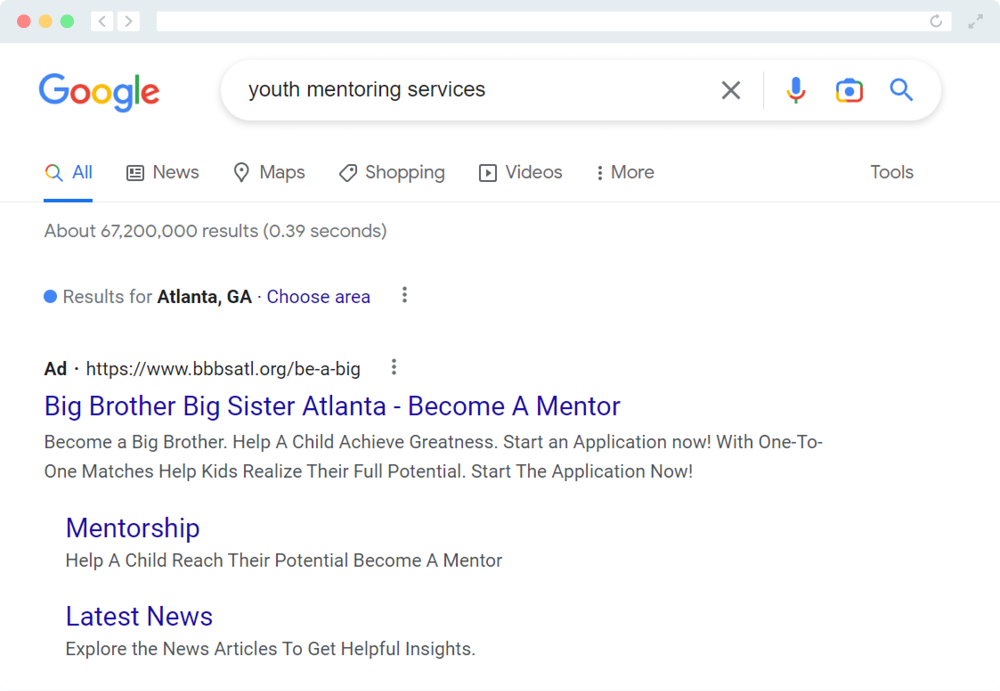
Google and the copywriters for this ad are making a few inferences about their audience. These include that the user:
- Is someone who wants to become a youth mentor rather than someone enrolling their child in youth mentoring services.
- Wants to engage with mentoring services in their local community.
- Cares about children and helping them reach their full potential.
These assumptions were not made haphazardly. Rather, both Google and Big Brother Big Sister Atlanta conducted audience research to determine what the average person searching this keyword wants to accomplish.
For your own audience research, analyze your supporter base. Explore donor data to identify trends in giving behavior, demographic information, and engagement rates. If you lack the information you feel you need to make inferences about your audience, consider surveying them directly or purchasing a data append to update and correct your donor data.
3. Prioritize clarity.
Audiences need to understand what you’re trying to say in your copy. While you may want to present a certain tone in your writing or create prose that stands out, do not do so if you are sacrificing clarity.
There are many principles for writing clearly and concisely. While we can’t conduct a course in writing right here, a few key style lessons that anyone can quickly pick up and apply to their writing include:
- Avoid “be” verbs. These include words like be, is, are, am, were, was, etc. Be verbs obscure who is completing a specific action, making your sentences vague or unclear. For example, consider this sentence: “The homeless population was given permanent housing.” This raises the question of who provided the housing when compared to this sentence: “Our nonprofit volunteers worked with the homeless population to provide permanent housing.” This sentence clearly explains who did what, making it easier to read and understand, while also properly attributing credit.
- Limit nominalizations. Nominalization is the practice of turning a verb or adjective into a noun. For example, “management” is the nominalization of “manage.” While some nominalization is normal, too much can make sentences unnecessarily long and complex. For example, compare these sentences: “We conducted a demonstration of why the removal of redwood trees is harmful” and “We demonstrated why removing redwood trees is harmful.”

- Keep your subject and verb close together. Sentences have three components: the subject, the verb, and the object. Not all sentences have an object, such as short sentences like “We donated.” However, all sentences have a subject and a verb, and the closer these two components are to each other, the easier the sentence is to understand. For example, compare “Local cats in the area, of which there are approximately 100 in number and many of which suffer from dehydration, ear and eye infections, and dangers from predators and traffic, can find refuge at our shelter” and “Local cats can find refuge at our shelter.”
Additionally, there’s no shame in needing a basic grammar refresh. Before writing your next fundraising appeal, ensure you know where to place your commas, how to avoid run-on and incomplete sentences, and exactly what a semi-colon is for.
4. Use storytelling strategies.
People tend to remember stories better than lists of facts. While compelling statistics and research certainly can be persuasive, factual evidence is usually most effective at converting those already interested in your cause.
To generate that interest, your copy needs emotional storytelling. Storytelling doesn’t mean writing a novel but rather sharing brief anecdotes and examples that have a beginning, middle, and end. A few key elements of nonprofit storytelling include:
- A single protagonist. Anyone can be the protagonist of your story, but nonprofit stories should follow just one individual. This helps focus your content and gives a specific character for audiences to identify with.
- Select details. Stories use details to paint a picture in readers’ minds. However, too many details can be distracting. When putting your stories together, select a few key details to include that you feel will stick with readers and help increase your stories’ memorability and emotional impact.
- A call to action. Nonprofit storytelling differs from regular stories by ending with some sort of request to the reader. This is called a call to action, and it might be to donate, sign up to volunteer, spread awareness, or just learn more about a specific issue.
When it comes to sourcing stories, you can interview beneficiaries, supporters, volunteers, team members, or anyone else related to your cause you think has a strong story to tell. When translating these interviews into prose, you can do some editing, such as summarizing and cutting tangents, but do not make up new details or remove essential ones. Doing so is unethical and can damage your credibility if discovered.
5. Grab readers’ attention.
Everyone hates clickbait, and your nonprofit should not use it in your copywriting. However, you can use a few lessons from clickbait to create compelling subject lines and post titles that grab interest. For example, try:
- Asking questions. Invite your audience to relate to your content by asking them a question. Avoid yes-or-no questions that readers may answer to themselves and keep scrolling. For example, “Is your home at risk of wildfires?” may be answered with a blunt yes or no. In contrast, “How at risk is your home from wildfires?” may invoke curiosity as users will be compelled to check their exact risk level.
- Selectively withholding information. The goal of a headline is to make readers want to learn more. While you should avoid deceptive headlines, you can selectively withhold details in your headline to generate curiosity, such as “We’ve discovered the key to fighting homelessness,” over “Mental health services and upfront financial support are the keys to fighting homelessness.” The former invites questions and intrigue, whereas the latter may make readers assume they already know the whole story and don’t need to read any further.
- Leading with a statistic. While stories are more memorable than numbers, a particularly bold statistic can draw audiences in. For example, you might publish a research report on your blog and feature one of the key findings right in the title to capture interest, such as “1 in 5 adults living in the U.S. suffers from mental illness.”
Additionally, while this guide is here to talk about copywriting, images and videos can be exceptionally useful for capturing attention. Videos, photos, and graphic design elements break up text, making your pages easier to read and more likely to grab the attention of users scrolling past.
6. Create a brand guide.
If you have several copywriters on your team, intend to hire an external copywriting service, or plan to let volunteers represent your nonprofit, you need a brand guide. Brand guides contain information about your nonprofit’s logo, brand colors, audience, marketing goals, and copywriting practices.
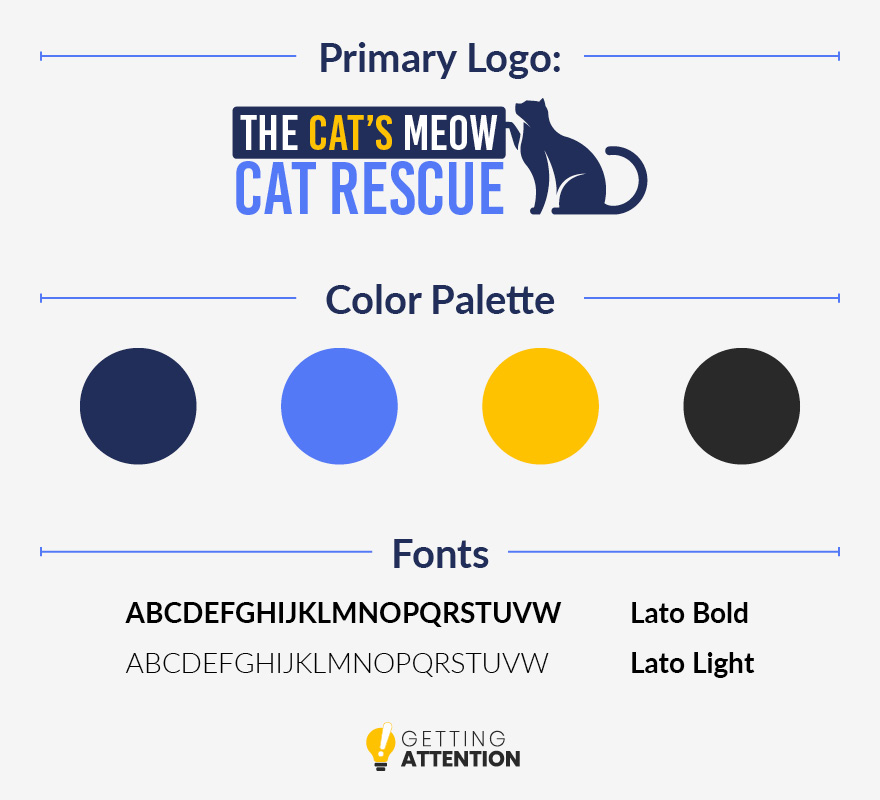
For copywriting, your brand guide should cover:
- Tone. How do you want your nonprofit to come off to readers? This could be professional, playful, casual, heartfelt, passionate, or anything else you feel shows off your brand identity and will get supporters invested in your organization.
- Specific phrases to use or avoid. If your nonprofit has a slogan, fact, or recurring idea you’d like to see expressed in your content, add it to your brand guide. Conversely, if there are terms to avoid, add those as well. For example, an environmental group might include a section in their brand guide that says“Use ‘climate change’ NOT ‘global warming.’”
- Differentiators. What makes your brand unique from other organizations? Your nonprofits selling products, your differentiators might be what makes your product offerings particularly useful, convenient, or high-quality, while nonprofits looking to fundraise should share why they specifically are the group that should tackle their target issue due to experience, a specific approach, or resources.
A brand guide helps every aspect of your marketing strategy, from copywriting to graphic design to presentations. Make your guide easily accessible so you can share it with new team members, volunteers, and third-party services.
7. Have a lot of ideas.
Not every idea you have for new content will be a winner. As part of the writing process, be prepared to come up with lots of ideas, draft several messages, and ultimately scrap most of them to find the best version possible.
As part of the brainstorming process, try:
- Working with many different team members who can bring their unique experiences and perspectives to the table.
- Staying up to date on the news, trends in your field, and updates on the nonprofit sector to learn what your audience is likely interested in.
- Using AI to help suggest blog titles. Not all of them will be useful, and you should use AI sparingly for your actual writing, but generative AI technology can automatically create as many ideas as you ask, meaning a few are bound to be good with a little tweaking.
To ensure the ideas you choose are the right ones, have someone edit all of your writing. Along with helping to catch typos, grammar errors, and stylistic issues that might slip past an automatic spellchecker, editors can fact-check, point out areas that are unclear or unpersuasive, and ultimately share whether they think the piece will succeed with your audience.
8. Issue calls to action.
We’ve already touched on calls to action (CTAs) briefly, but given their importance in nonprofit marketing, let’s dive a bit further into what makes a compelling CTA:
- Create a sense of urgency. How often have you opened an email and intended to respond to it but decided to do it later and never got back around to it? The same exact thing happens to your supporters when they open your messages, and you can combat this by creating a sense of urgency. In your CTAs, explain why it’s vital for donors to give as soon as possible. For example, in a fundraising appeal, you might mention an ongoing matching challenge, how close you are to reaching your fundraising goal, or what your nonprofit will be able to do with the funding.
- Issue only one CTA at a time. In short content like emails, text messages, and letters, issue just one CTA. Multiple CTAs pull supporters in multiple directions, often resulting in them taking no action. Plus, an email asking supporters to donate, volunteer, and sign up for a membership program likely isn’t very focused or easy to read.
- Infuse your brand or cause into your CTAs. As long as it’s clear what supporters will accomplish by clicking on your CTA, you can get creative with the language used. For example, instead of just “Donate,” your CTAs might say, “Donate to save a child.”
Outside of copywriting, for the actual design of your CTAs, use your brand colors strategically to make them stand out. For instance, if your colors are white and red, like the American Heart Association, you might have white text on a red button.
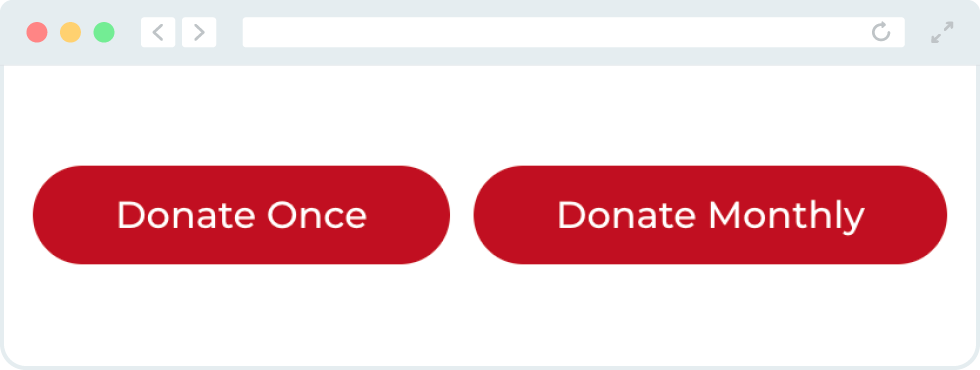
9. Follow SEO best practices.
As part of marketing your content, your copywriters should be aware of SEO best practices. SEO stands for search engine optimization, and as the name implies, it’s the process of optimizing your content to rank highly on search engine results pages. When your website content appears for relevant keywords, your website can attract more supporters, customers, and advocates.
A tricky part of SEO writing is knowing how to use keywords. Optimizing your content for specific keywords increases the chances it will rank for that specific word or phrase. However, overloading your content with these terms can result in keyword stuffing, which creates a negative user experience and can get your website penalized if a search engine picks up on it.
When it comes to keyword optimization, copywriters can generally rely on this advice:
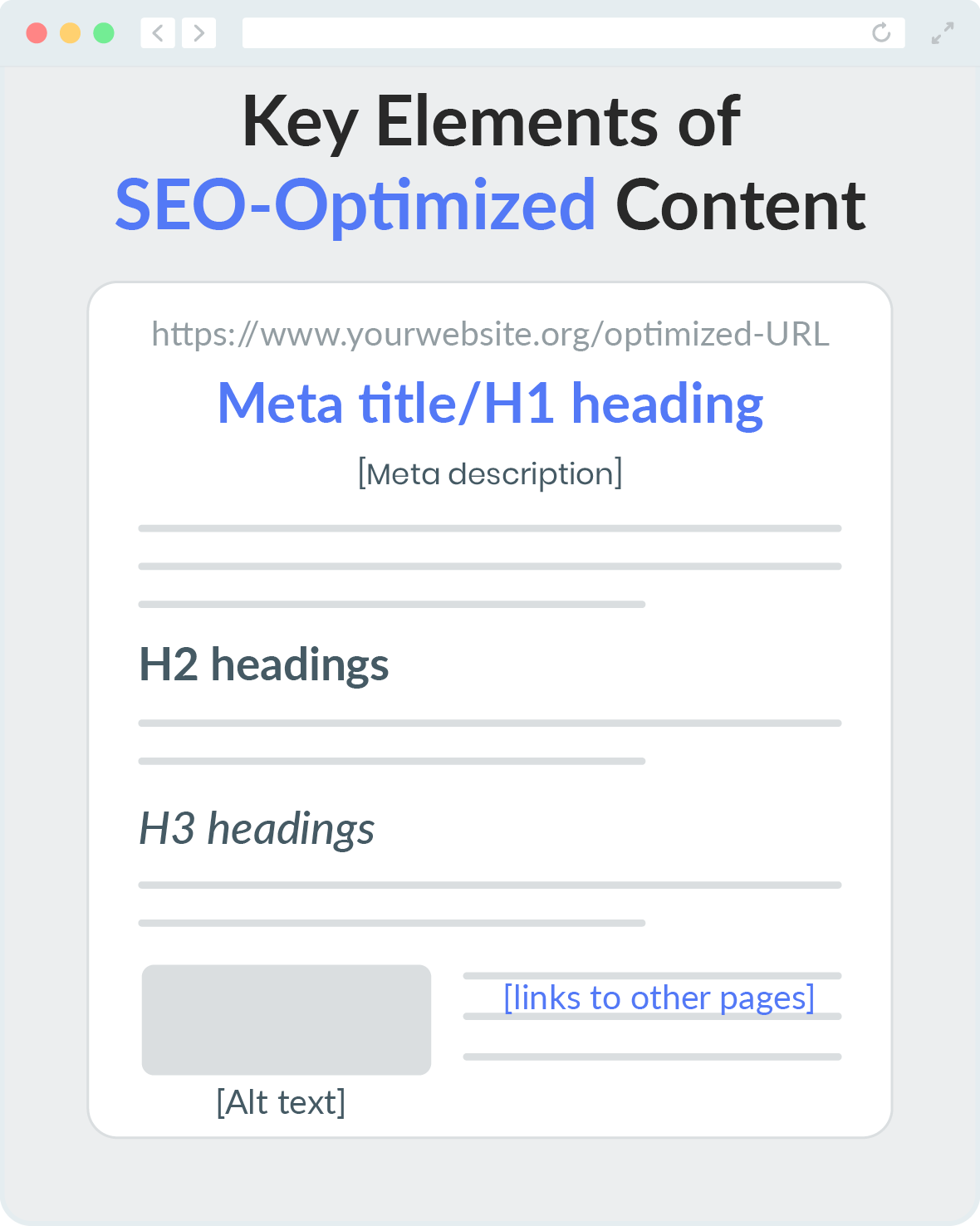
- Title and headings. Your page title should feature your target keyword, and headings should feature the keyword where appropriate and natural. Try adding variations to fit your content. For example, if your keyword is “professional development courses,” you might use the keyword variant “professional development skills” in a heading.
- Body text. Above all, your content should be natural and valuable. If it makes sense to use your keyword in a sentence, go for it. If you have to shoehorn it in, consider a variant or just decide to skip that opportunity. Using keywords too much and inappropriately can result in keyword stuffing.
- Alt text. If possible, try to incorporate your keyword naturally into your images’ alternative text. However, the primary purpose of alt text is to allow visitors using screenreaders and other assistive technology the ability to navigate your page and have a similar experience to other visitors. This means your alt text should, above all else, accurately describe your images first and factor in keywords second.
Additionally, consider each page’s meta description. While meta descriptions are not taken into account for search engine rankings, they can determine whether a user decides to click on your content. Think of SEO as getting your content in front of users and the meta description as determining whether they actually click on it.
Additional Nonprofit Marketing Resources
Copywriting is a core part of all nonprofit marketing, and when done well, it’s one of your most reliable tools for connecting with supporters, no matter where they are in their donor journey. To take your copywriting to the next level and secure more high-value leads, follow the tips in this guide or consider working with a third-party copywriting agency.
To improve your nonprofit marketing strategy even further, check out these resources:
- Top 2023 Nonprofit Marketing Trends to Inform Your Strategy. Staying on top of trends helps your nonprofit stand out. Learn what the future of marketing holds in this guide.
- Digital Marketing for Nonprofits Made Easy: A Helpful Guide. Online marketing has unique limitations and opportunities. Discover how to make all of your messages stand out online.
- A Great Google Grant Agency in 2024: 10 Best Partners. Ready to access a marketing channel with an audience of thousands for free? Take the next step in applying for the Google Ad Grant by working with a Google Grant agency.
